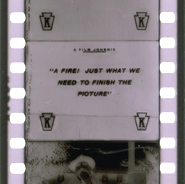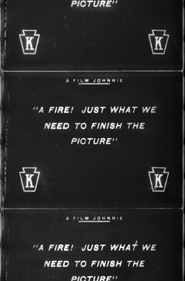Step 3 - The decision-making process
Choosing which materials to use, in preservation and restoration work takes skill, precision and a lot of patience. Choices must be made about which elements to examine and the 'forensic' work must be recorded as to the provenance of the element, condition and completeness.
Claire, like any archivist in this position, was gathering information about A Film Johnnie, as a text, by deduction from the physical nature of the copies. Their provenance and any relationship between them are embodied in the films.

The manufacturer's code for the year in which the stock was made might be printed along the edge, for example. The marks of the previous generation (the copy, negative or positive, that another copy was printed from) might have been reproduced on the edge as well. Sometimes the generation of a copy can be calculated from the number of perforations printed into the image. For example, if a positive has a single black shape of a film perforation printed on the edge of its own perforations it was made from the original negative.

One important mark is the distinctive Keystone splice. When the shots were joined in the original negative, the join (splice) was very wide and printed well into the picture. This is valuable because it tells us which was the last and first frame of a shot and indicates the original order of the shots.
Claire found several of these printed into an National Archive negative, made from a section of a Keystone print. The print itself has decomposed since the negative was made in 1948 but can be identified as a Keystone print because it includes several Keystone splices and two intertitles. Ironically, the shots of the burning house, nos. 57 and 63 in the shot list, are not present in this negative. We decided the shots were not later additions because the joins printed in the negative at these points were physical joins in the print from which the negative was made, rather than the Keystone negative splice.
She also had to decide on the most accurate wording and position of intertitles. We knew from previous examples that the WH Productions reissues generally used almost exactly the same wording as the Keystone titles, although in a new design. The National Archive nitrate prints of A Film Johnnie were the WH Productions reissue (as is the negative from the Library of Congress), while the nitrate dupe negative of a Keystone print, described above, contained two original intertitles (nos. 5 and 6).


The wording of these in the WH Productions version matched exactly, with only the line breaks in title 5 differing slightly (see report PDF, 630kb).
Claire used her intensive comparison of the copies and evidence from secondary sources to arrive at the best possible reproduction of the film's original editing. She then had the tricky job of identifying what would be the source of each shot. This is more complicated than finding in which copy a shot is longest. The decision means weighing the length of the footage against image quality and characteristics. To swap between sources quickly might make their differences highly distracting.
After making her decisions, Claire passed all the material to the lab for printing.
Making decisions for a Keystone restoration.
Having trouble with streaming media on this page? Visit our
help page.

Documents on this page are available in Adobe PDF, which requires Adobe's free reader.
If you are having trouble viewing PDFs, please consult our
help page.




